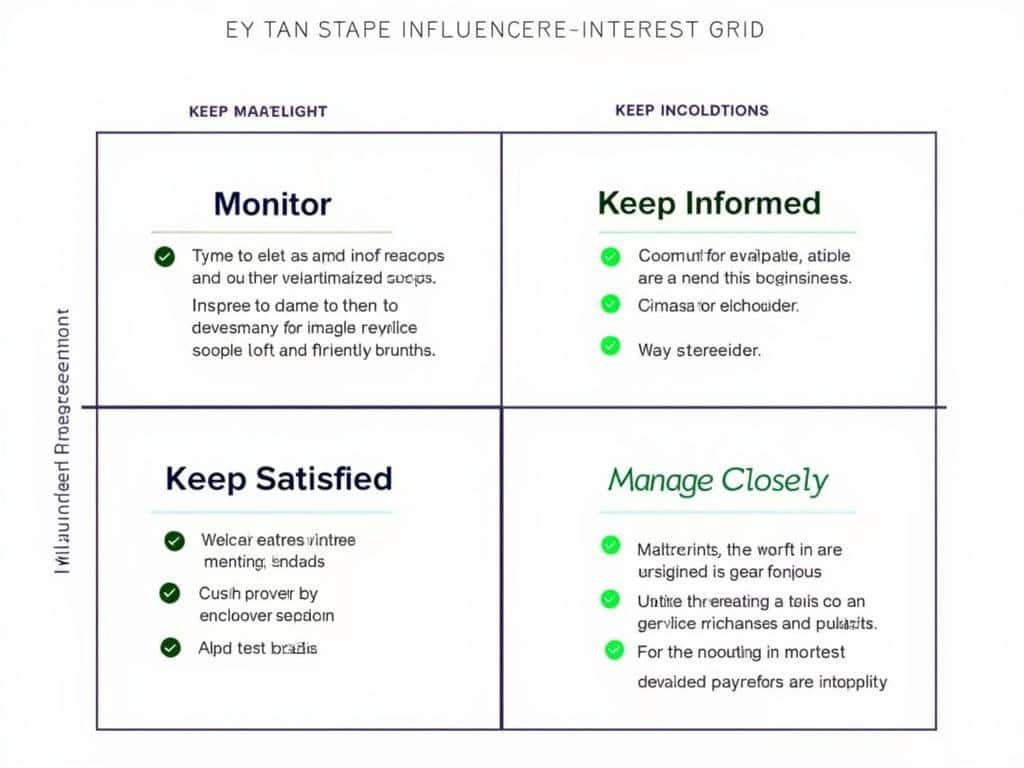
Understanding the Influence Interest Grid for Stakeholder Management
The influence interest grid for stakeholders functions as a strategic visualization tool that plots stakeholders according to their power levels and interest in a project. This two-dimensional matrix sorts stakeholders into four key quadrants—Monitor, Keep Informed, Keep Satisfied, and Manage Closely—enabling you to prioritize your engagement efforts effectively.
How the Influence Interest Grid Transforms Stakeholder Relationships
The influence interest grid gives you a systematic method to distribute limited resources where they’ll create the most impact. By mapping stakeholders based on their decision-making authority and investment in outcomes, you can craft targeted communication strategies that address each stakeholder’s specific needs. This approach prevents the common mistake of giving equal attention to all stakeholders, which often wastes resources and misses chances to gain support from high-influence individuals whose backing is essential for project success. When correctly applied, this structured method boosts project alignment with organizational goals and increases stakeholder satisfaction.
The grid helps you identify which stakeholders need more attention and which require less frequent communication. For those with high influence but low interest, you’ll want to keep them satisfied with regular updates. Stakeholders with high interest but low influence should be kept informed about project developments. Those with both high influence and high interest need to be managed closely through consistent engagement and personalized communication.
Your stakeholder management strategy becomes more efficient when you can visualize these relationships and adjust your approach accordingly. This targeted engagement saves time, improves stakeholder relationships, and increases the likelihood of project success.
Effective stakeholder management can increase project success rates by up to 70%.
Using the Influence Interest Grid for Stakeholders
Using the influence interest grid for stakeholders transforms your project management strategy by creating clear priorities for stakeholder engagement. This practical tool helps you categorize stakeholders into four distinct quadrants based on their power and interest levels. You’ll quickly identify which groups need your immediate attention and which can be managed with less intensive approaches.
Visual Mapping of Stakeholders
The grid creates a visual map showing stakeholders in “Monitor,” “Keep Informed,” “Keep Satisfied,” and “Manage Closely” categories. This visualization isn’t just helpful—it’s essential for making smart decisions about where to focus your communication efforts and resources. Your stakeholder analysis becomes more structured and actionable when using this framework.
Adaptive Engagement Tactics
The beauty of this approach lies in its simplicity. You can easily adjust your engagement tactics based on where stakeholders fall on the grid. High-power, high-interest stakeholders deserve your most thorough communication plans, while those with less influence might require only periodic updates. This strategic allocation of time and attention helps prevent resource waste and strengthens relationships with key decision-makers.
1. Map Your Stakeholders
The first step in creating an effective influence interest grid for the stakeholders is comprehensive identification. Begin by developing a complete list that captures all parties with a stake in your project’s outcome. Your stakeholder mapping should include both internal stakeholders (team members, department heads, executives) and external stakeholders (clients, suppliers, regulatory bodies, community groups).
Document each stakeholder’s specific role and their relationship to the project, noting their official position, department, and organizational hierarchy. Consider using stakeholder identification techniques to ensure no important groups are overlooked. This foundational mapping provides clarity about who might impact your project and whose support you’ll need.
When creating your list, categorize stakeholders by department, function, or relationship type to organize your approach. Include contact information and preliminary notes about their potential expectations or concerns. This thorough mapping becomes the foundation for your entire stakeholder management strategy.
2. Assess Power Levels
When creating an influence interest grid for stakeholders, accurately evaluating power levels is crucial for developing effective engagement strategies. You need to carefully analyze each stakeholder’s decision-making authority within the organization or project context. Consider how much formal authority they possess to approve, delay, or veto project decisions.
Examine their influence over other stakeholders as this can significantly impact your project’s success. Some stakeholders may hold limited formal authority but exercise considerable informal influence through relationships and networks. This stakeholder satisfaction factor is critical to assess properly.
Rate each stakeholder’s access to resources and control over budget allocations on your project. Those with financial decision-making power typically rank higher on the power scale. You can use the following criteria to help evaluate power levels:
- Position within organizational hierarchy
- Control over critical project resources
- Ability to influence other key stakeholders
- Technical expertise or specialized knowledge
- Historical influence on similar past projects
Score each stakeholder’s power level on a scale of 1-10, where 1 represents minimal influence and 10 indicates maximum authority. This numerical approach helps create a more objective influence interest grid for stakeholders that you can reference throughout your project lifecycle.
Expert Insight: Accurately assess stakeholder power levels by evaluating their formal authority, influence on others, and access to resources. Use a 1-10 scoring system to objectively rank power, ensuring your influence interest grid effectively guides your engagement strategies throughout the project lifecycle. Prioritize stakeholders with critical decision-making capabilities for success.
3. Measure Interest Levels
Measuring stakeholder interest levels is a critical component when developing an influence interest grid for the stakeholders in your project. Begin by determining each stakeholder’s involvement in project outcomes, as this reveals their inherent motivation to engage with your initiative. Stakeholders with direct connections to deliverables typically demonstrate higher interest levels.
Next, evaluate potential gains or losses for each stakeholder. Those standing to benefit significantly from your project’s success will naturally show greater interest than those with minimal skin in the game. This assessment helps you understand the underlying drivers of stakeholder behavior and engagement.
It’s equally important to assess their current engagement level. Look for indicators such as:
- Attendance and participation in project meetings
- Responsiveness to communications
- Willingness to provide resources or support
- Frequency of inquiries about project status
Finally, rate each stakeholder’s interest on a scale of 1-10, where 1 represents minimal interest and 10 indicates maximum investment in project outcomes. This quantitative approach allows for effective stakeholder identification and ensures you can prioritize your engagement efforts appropriately based on measured interest levels rather than assumptions.
Expert Insight: To effectively engage stakeholders, assess their interest levels by evaluating involvement, potential gains or losses, and current engagement indicators. Rate interest from 1-10 to prioritize engagement efforts based on measurable data rather than assumptions. Understanding these dynamics facilitates stronger relationships and project success.
4. Plot Stakeholders on the Grid
Once you’ve assessed both power and interest levels, it’s time to create your influence interest grid for the stakeholders. Start by drawing a 2×2 matrix with power (influence) on the vertical axis and interest on the horizontal axis. This visual representation helps you categorize stakeholders effectively.
Position each stakeholder on the grid based on their previously determined scores. For greater precision, you can use the numerical ratings (1-10) you assigned earlier to place them accurately on the grid. After plotting all stakeholders, you’ll notice natural groupings forming in the four quadrants.
Label each quadrant according to its management approach: “Monitor” (low power, low interest), “Keep Informed” (low power, high interest), “Keep Satisfied” (high power, low interest), and “Manage Closely” (high power, high interest). This influence interest grid becomes a powerful stakeholder management tool that guides your engagement strategies throughout the project lifecycle.
The visual nature of the grid makes it easy to identify which stakeholders require the most attention and resources, helping you prioritize your communication efforts effectively.
Expert Insight: Utilize an influence interest grid to categorize stakeholders based on their power and interest levels. Plotting stakeholders accurately helps prioritize communication efforts by visualizing which groups require the most attention. Label each quadrant accordingly to streamline your engagement strategies throughout the project lifecycle.
5. Develop Engagement Strategies
After plotting stakeholders on the influence-interest grid, you need to create tailored engagement approaches for each quadrant. Begin by developing specific communication plans that address the unique needs of each stakeholder group. High-power, high-interest stakeholders require comprehensive engagement with frequent updates and direct involvement in decision-making processes.
When scheduling check-ins, consider the stakeholder’s position on the grid. Those in the “Manage Closely” quadrant may need weekly meetings, while “Keep Informed” stakeholders might require bi-weekly or monthly updates. This stakeholder engagement approach ensures you’re allocating the right amount of attention to each group.
Resource allocation should directly correspond to stakeholder priority levels. Dedicate more time and project resources to high-influence stakeholders while maintaining appropriate engagement with all groups. Document each stakeholder’s preferred communication channels and optimal frequency for outreach – some may prefer emails while others respond better to face-to-face meetings or video calls.
The following elements should be included in your engagement strategy documentation:
- Communication method preferences (email, calls, meetings)
- Required frequency of updates
- Key messaging points for each stakeholder group
- Decision-making involvement level
- Escalation protocols for issues
Expert Insight: Tailor engagement strategies by aligning communication plans with stakeholders’ needs and grid positions. Allocate resources based on influence and interest levels, ensuring frequent and appropriate updates. Document preferences and involvement levels to enhance relationship management and facilitate effective decision-making processes.
The influence interest grid for stakeholders is a strategic visual tool that categorizes project participants based on their power levels and interest in outcomes, enabling targeted engagement approaches. By mapping stakeholders on this 2×2 matrix, project managers can efficiently allocate resources and communication efforts to those with the most significant impact on project success.
The influence interest grid for stakeholders is essential for business and enterprise users as it transforms complex stakeholder relationships into actionable management strategies. Organizations implementing this approach experience improved project outcomes through optimized resource allocation, reduced communication waste, and enhanced stakeholder satisfaction, ultimately preventing the costly consequences of mismanaged relationships like project delays, budget overruns, and organizational resistance to change.
Mastering Stakeholder Management
The influence interest grid represents a powerful framework for categorizing stakeholders according to their power and interest levels, enabling project managers to develop targeted engagement strategies. By systematically identifying stakeholders, assessing their influence and interest, plotting them on the grid, and creating appropriate communication plans, organizations can significantly enhance project outcomes through improved relationship management. This methodical approach ensures resources are allocated efficiently, with high-power stakeholders receiving appropriate attention while maintaining suitable engagement across all quadrants of the matrix.
Key Action Steps for Implementation
- Create a comprehensive stakeholder list including both internal team members and external parties
- Evaluate each stakeholder’s decision-making authority on a 1-10 scale
- Assess interest levels by analyzing potential gains/losses and current engagement
- Draw a 2×2 matrix with power on the vertical axis and interest on the horizontal
- Plot each stakeholder on the grid based on their scores
- Label quadrants as “Monitor,” “Keep Informed,” “Keep Satisfied,” and “Manage Closely”
- Develop tailored communication strategies for each quadrant
- Document stakeholder communication preferences and required frequency
- Allocate resources proportionally based on stakeholder priority
- Schedule regular reviews of the stakeholder grid as the project progresses
Frequently Asked Questions
- What exactly is an influence interest grid for stakeholders? An influence interest grid is a 2×2 matrix that plots stakeholders based on their power (vertical axis) and interest (horizontal axis) in a project, creating four quadrants that guide different management approaches: “Monitor,” “Keep Informed,” “Keep Satisfied,” and “Manage Closely.”
- How often should I update my stakeholder grid? The stakeholder grid should be reviewed and updated at key project milestones, when significant changes occur, or at regular intervals (typically monthly for longer projects) to reflect evolving stakeholder dynamics and interests.
- What’s the difference between power and influence in stakeholder analysis? Power typically refers to formal authority within an organization, while influence encompasses both formal and informal ability to affect decisions. Someone might have high influence through networks and relationships despite having relatively low positional power.
- How should I engage with stakeholders in the “Monitor” quadrant? For stakeholders with low power and low interest (Monitor quadrant), maintain minimal but consistent communication through periodic updates or newsletter-style communications, ensuring they remain informed without investing significant resources.
- What’s the best way to measure stakeholder interest levels? Measure interest by evaluating stakeholders’ involvement in project outcomes, potential benefits or losses, meeting participation, responsiveness to communications, and willingness to provide resources, then rate on a 1-10 scale for objective comparison.
- How can I manage stakeholders who shift between quadrants during a project? When stakeholders shift between quadrants, promptly adjust your engagement approach to match their new position, document the change and its causes, and communicate any modifications in engagement strategy to your team to maintain alignment.






